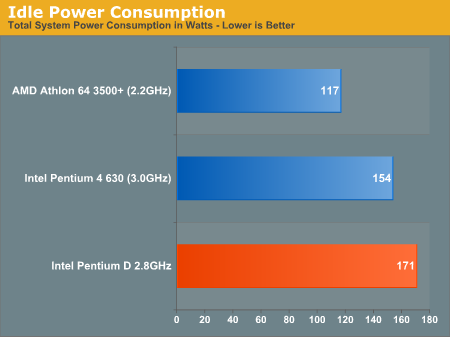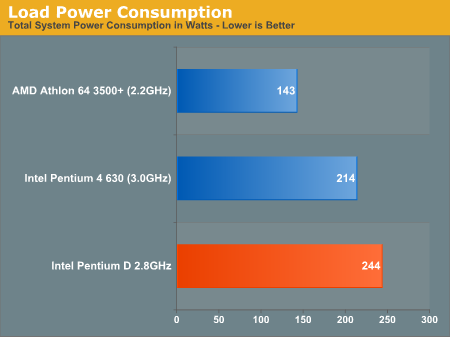Intel Dual Core Performance Preview Part II: A Deeper Look
by Anand Lal Shimpi on April 6, 2005 12:23 PM EST- Posted in
- CPUs
I'll admit, dual core has me excited for many of the reasons outlined in Part I. A big part is that personally, I've been using multiprocessor systems in my main computer for years. I've always appreciated the benefits of multiprocessor platforms, but recommending one for a desktop user has never been really feasible. Even the cheapest 2P workstation motherboards were at least twice the price of a desktop motherboard, not to mention the cost of the CPUs. The mass market had a short affair with multiprocessing in the days of the ABIT BP6 and the Celeron 300A, but in the grand scheme of things, that was barely a blip on the radar. Now, for the first time, both AMD and Intel are ready to bring the type of robustness of multiprocessor platforms to the desktop with their dual core offerings.
Part I focused on what dual core can offer, but now it's time for a much more practical look. We've never recommended Intel's Extreme Edition line of processors nor AMD's FX series, both supposedly marketed to gamers, but not purchased by any of our gaming readers. The processors that we recommend are usually much better values for the price, and thus, today's comparison isn't based around the most expensive dual core offerings, but rather the cheapest.
A point we made in the first article was that Intel's pricing strategy for dual core is extremely aggressive, with the cheapest 2.8GHz Pentium D soon to be introduced at $241. The problem is that at only 2.8GHz, the Pentium D won't have the strongest single threaded performance, which puts buyers in a sticky situation - do you buy an Athlon 64 3500+ for great single threaded performance or will the Pentium D give you a better overall multitasking experience? Intel doesn't do much to complicate the situation, as the Pentium D 2.8GHz will be close in price to the Pentium 4 630 (3.0GHz), which isn't much of a clock speed advantage. AMD will eventually have competitively priced dual core parts, but right now, AMD doesn't appear to be looking at the mainstream desktop market for dual core Athlon 64 chips.
The three chips mentioned above are the basis of the majority of today's comparison, but the decision is far from clear cut. Let's find out why.
Power Consumption
We'll start with power consumption - the contenders? A 90nm Athlon 64 3500+ vs. the Pentium 4 630 and the dual core 2.8GHz Pentium D. As always, we measured total system power at two states: idle and under a full load. For our full load test, we used a multithreaded application, 3ds max 7, performing the CBALLS2 render test from the SPECapc benchmark.


The K8 architecture simply lends itself to lower power consumptions than Intel's high frequency approach to computing with the Pentium 4 (especially Prescott). The move down to 90nm really reduced AMD's power consumption a lot, to the point where the 90nm Athlon 64 3500+ actually consumes less power under full load than the Pentium 4 630 at idle.
The Pentium 4 vs. Pentium D comparison is also interesting, as the 2nd core doesn't add all that much to overall system power consumption. In this case, we're looking at an increase in overall system power consumption by less than 15%. Intel still doesn't win in the power consumption department though; if you want something cool and quiet, AMD is still the way to go.
The Test
Our hardware configurations are similar to what we've used in previous comparisons.
AMD Athlon 64 Configuration
Socket-939 Athlon 64 CPUs
2 x 512MB OCZ PC3200 EL Dual Channel DIMMs 2-2-2-10
NVIDIA nForce4 Reference Motherboard
ATI Radeon X850 XT PCI Express
Intel Pentium 4 Configuration
LGA-775 Intel Pentium 4 and Extreme Edition CPUs
2 x 512MB Crucial DDR-II 533 Dual Channel DIMMs 3-2-2-12
Intel 955X Motherboard
ATI Radeon X850 XT PCI Express










106 Comments
View All Comments
saratoga - Friday, April 8, 2005 - link
#90:HT is the same thing as SMT. You can thank Intel's marketing for that one.
Reflex - Friday, April 8, 2005 - link
#93: Intel has labeled it as SMT, however there is another name for what they are doing(that I cannot remember at the moment). What they are calling SMT is nowhere even close to solutions like Power.That aside, the implementation Intel has chosen is designed to make up for inefficiencies in the Prescott pipeline, such a implementation would make zero sense on the Athlon architecture, it does not share the same inefficiencies that the P4 design has. It would actually harm rather than help performance.
True SMT is not a 'bolt on' feature. Its something that has to be planned for from the very beginning of the CPU design cycle. You could not in any way add it to the current Athlon design and gain any performance. Whatever their next generation is may include it, it depends on what direction they decide to go, but you will not see it on the current generation, and thats actually a good thing as it would be purely a marketing move.
eeceret - Friday, April 8, 2005 - link
As always a very interesting article, one thing comes to mind though... In the gaming multitasking tests you adjusted the priority of the DVD Shrink process to see the effect on gaming performance. What I was wondering is if you could take a look at what effect explicitly binding the processes to seperate cores (processor affinity) has on gaming performancedefter - Friday, April 8, 2005 - link
Hyperthreading IS SMT. SMT stands for symmetric multithreading (ability to run two or more threads at once and this is exactly what hyperthreading does.Of course, CPUs from different manufacturers have vastly different internal structures, thus also the SMT is implemented differently.
"Intel's next major IA-32 processor release, codenamed Prescott, will include a feature called simultaneous multithreading (SMT)"
http://arstechnica.com/articles/paedia/cpu/hyperth...
tynopik - Friday, April 8, 2005 - link
and of course that's just the net part, don't want to leave out other background tasks like that resource sucker outlook and playing flac/ape filestynopik - Thursday, April 7, 2005 - link
to get repeatable multi-tasking/ncq benches, anand is going to have to bite the bullet and setup a full-blown network simulation:1: an nntp server
2. a bittorrent swarm
3. an irc server
with this setup, you can test these multi-tasking scenarios that seem more reasonable:
1. firewall (a pig like zonealarm)
2. pulling news articles with either 2 clients or 1 client with 2 threads (writing to different places on hd simultaneously)
3. about 10 torrents where it is BOTH downloading and uploading (so pulling from a gazillion different places on hd at once)
4. mirc with about 5 open channels and some scripts (like filters). At least one channel should be very high traffic (like #mp3passion on undernet)
5. icq
6. running all this with software raid 5
this would represent a typical background load, and then you can benchmark foreground tasks to see how much they are affected by what's going on in the background (specifically ncq could be tested by seeing how long it takes to copy a file from one partition to another under these circumstances)
Reflex - Thursday, April 7, 2005 - link
Just to be clear: SMT is NOT the same thing as HyperThreading. They go about what they are doing in radically different ways. The only similarity is in the CPU being able to execute two simultanious threads. How it goes about that though is implemented completely differently.Reflex - Thursday, April 7, 2005 - link
"#47, if HT is simply a "bandaid", then why is AMD the only major CPU vendor not using it? IBM uses it heavily in their Power5, Sun is making their next CPUs (Niagra) very highly SMT (same thing as HT). Arguably, both of those architectures have much more shallow pipelines than the P4, yet see reason to provide SMT. AMD is the only holdout."The SMT used in IBM's Power series is completely different from what Intel is doing with the P4 design. The only similarity is the fact that two threads can be run at once, the implementation has nothing even close to the same however. I do not have details on Sun's implementation, but I would assume it will be closer to IBM's than Intel's implementation considering the market they are targetting. The Power architecture was designed from the ground up to use SMT, it wasn't a tacked on feature, and you get considerably more of a performance boost in most scenerios with it than you would ever see with HT on Intel.
The Athlon64 architecture was not designed with SMT or HT in mind, it was designed around two physical cores. So adding HT to it would do very little, and SSE3(which mostly optimizes HT style multithreading) does almost nothing on the K8 architecture.
Not every feature would help every CPU design, it all depends on what was taken into account when the design was made. Power has some limitations you do not see on x86(in order execution for example), and x86 has challenges you do not see on Power. The multi-threading implementations are similarly different and not comparable. In the x86 world, HT makes sense on Intel in some situations(not always). It makes no sense on AMD and would likely result in performance drops rather than gains. It certainly would not improve performance in any way as the core does not often have idle units or execution steps due to its design.
Icehawk - Thursday, April 7, 2005 - link
"I'm also curious to see what effects RAID would have on testing striped setups."Uh, delete the "striped setups" from the end ;)
Can we please, please get some kind of short-term editing abilities here?
Icehawk - Thursday, April 7, 2005 - link
So you'd rather wait for information than recieve it now?Anand clearly shows that dual core is only a good choice now IF you use it in scenarios where it can run multiple applications. Otherwise, single core chips are still the better choice. So i don't see the marketing hype you are referring to. Basically we've been told now for quite a few years that multi-taskers can benefit from multiple CPUs but the costs have been prohibitive. Now it looks like within the next year a 2 CPU machine will cost no more than previous single core processors.
Thanks Anand for helping us out in planning for the future! The DVDShrink stuff was very interesting to me as was the NCQ information - makes switching to SATA drives a bit more appealing to me considering my usage profile.
I just recently went from 1.4 k7->3.2 P4 w/HT so I'm pretty happy at this point. It does look like a dual core system *might* allow me to get rid of my second box (the 1.4 K7) which would save me money in the long run - one less PC to power up and cool off. My home office requires year round A/C to cool my 2 21" CRTs and 2 PCs...
I'm also curious to see what effects RAID would have on testing striped setups. I'm very curious if a RAID5 type of setup with NCQ and a dual-core might make chores like encoding & gaming realistic - it sounds like from the review that at this point I/O may cause hiccups even when the processor still has headroom.